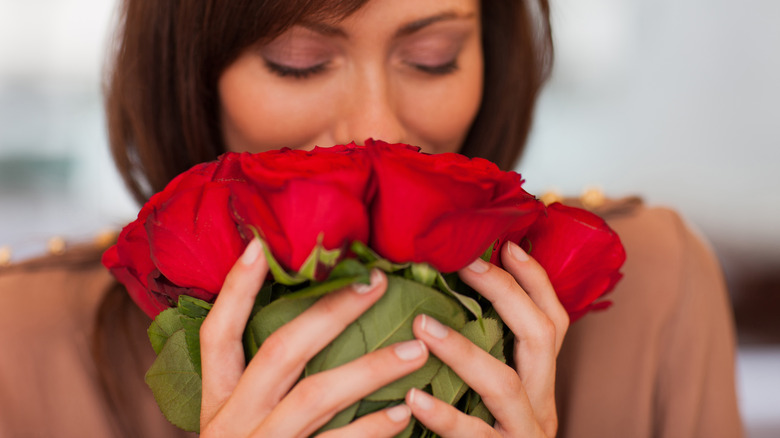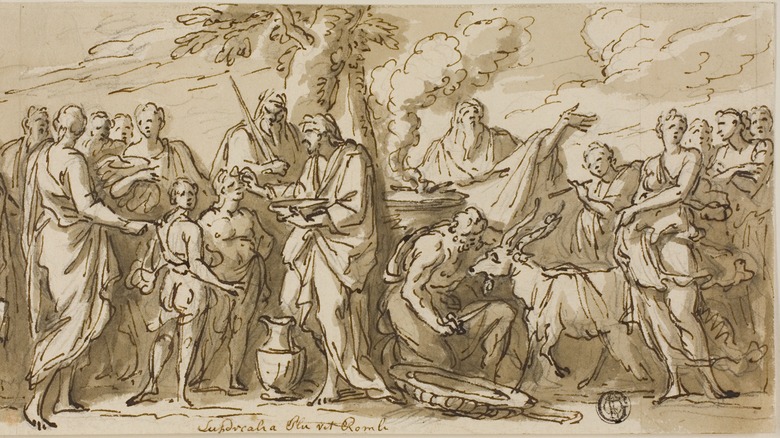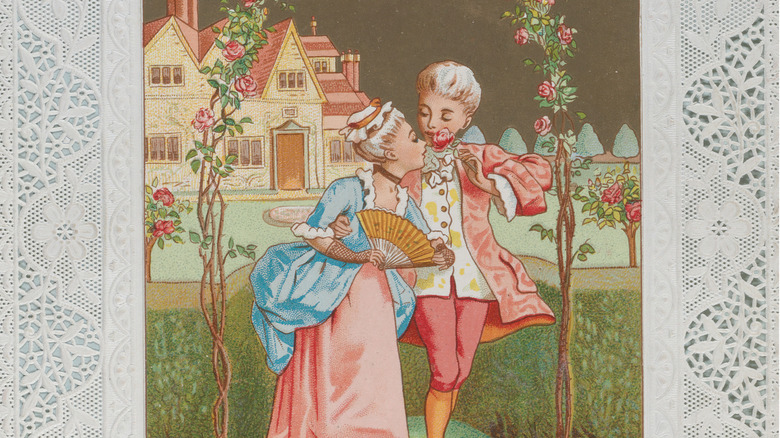Here's The Reason Your Boo Sends You Flowers On Valentine's Day
Have you asked anyone to be your Valentine this year? According to a survey by Petal Republic, about 52% of Americans planned to formally celebrate Valentine's Day in 2021, whether that meant going on a date, buying gifts for their partner, or just spending time snuggled up on the couch. Even single people wanted to get in on the Valentine's fun; about 12% of women and 11% of men planned to treat themselves in lieu of a partner. Whether you're mentally skipping the holiday or you've already planned your Valentine's Day themed makeup, it seems like Cupid is always on the horizon. If you plan on participating in all the fun and flirty festivities this year, it's never too early to start thinking about your Valentine's gifts. Chocolates, cards, roses, and red wine make some of the sweetest presents, but have you ever wondered why these gifts became common — or even expected — around Valentine's day?
Valentine's Day traditions (as we know and love them today) come from a long history shrouded in myths and legends — but Valentine's Day flowers, in particular, have some especially unique stories behind them. You might be wondering, what's so special about flowers? Why do some flowers seem more romantic than others, and why do we like to give them on Valentine's Day? To help you appreciate your bouquet this Valentine's day, we'll dive into the lore behind this romantic gesture.
The lovely origins of Valentine's Day
Like many Western holidays, Valentine's Day likely sprouted from both Christian and pagan roots. Every year on February 15th, the ancient Romans celebrated Lupercalia. This was a festival to please the she-wolf mother of Romulus and Remus and improve fertility among Roman women (via History). Lupercalia was quite different from our idea of a cutesy winter holiday. It included animal sacrifices, a massive feast, and Roman priests running naked through the streets to whip women with strips of fresh goat skin. Romantic, right? Despite the all-out insanity, Lupercalia actually presented a good matchmaking opportunity. Randomly paired couples would dance, feast, and even have sex together. These couples would often fall in love and stay together long after the festival ended.
The history surrounding St. Valentine himself is a little foggy, but there are two main legends told today. One story states that the Roman emperor Claudius II forbid his soldiers from marrying or having children, believing that single men made better fighters. Despite the new law, St. Valentine continued to marry young lovers in secret, but he was eventually imprisoned and executed on February 14th, 270 A.D. (via History). Another story states that Valentine was caught helping Christians escape from Roman prisons. St. Valentine fell madly in love with the jailer's daughter, and before his execution, he wrote a letter to the young woman, signing it, "from your Valentine." Thus, "Valentine" became a term of endearment.
The romanticization of roses
What do unfortunate saints and animal sacrifices have to do with giving flowers today? Like Lupercalia and St. Valentine, roses also have deep connections with Roman and Greek mythology. Aphrodite, the goddess of love, supposedly cut her foot on rose thorns while running to rescue her lover, Adonis. According to the story, her blood splashed on the white roses, staining them red forever. In another story, Aphrodite's son, Eros, bribed another god with roses so he wouldn't tell anyone about Aphrodite's love affairs (via Discover Magazine).
Over time, the history and symbolism surrounding Valentine's Day became less bloody and more palatable to a modest, well-mannered society. Floriography, the study of communication through flowers, was a big deal in the Victorian era. Red flowers, especially roses, were used to symbolize strong feelings of love, passion, and seduction. Giving someone a bouquet of roses meant that you were serious about pursuing a romantic connection. Of course, there were other flowers you could use to show emotions without pledging your die-hard devotion. Pink roses expressed feelings of admiration, sweetness, and gratitude, while white roses represented purity, innocence, and joy. According to Salisbury Greenhouse, giving someone a bundle of yellow roses could mean you appreciate their friendship, but it could also signify infidelity, jealousy, or falling out of love. Ouch.
Flowers are the ultimate Valentine's gift
Valentine's Day became popularized as a holiday around the mid-1800s. Creative minds knew how to capitalize on the public's growing desire for a happy, romanticized life like they had read about in books. Esther Howland became known as the "mother of the American Valentine" after she began designing and marketing cards decorated with lace, birds, cherubs, and of course, flowers (via Mount Holyoke). At a time when most women's marriages were still arranged by their fathers, Valentine's cards, gifts, and flowers introduced the radical idea that people could find and pursue relationships because they were in love, rather than for pure practicality.
Flowers have most likely remained a popular Valentine's Day gift because they are accessible to people across all economic and social classes, and they're a strong symbol of love around the world. You don't have to purchase five pounds of chocolate or dozens of cards to impress your sweetheart. All you have to do is harvest some blooms from your own backyard to surprise them with your devotion. While there are many historical and social factors behind the tradition of giving flowers on Valentine's Day, the real reason your darling sends you flowers is that they care deeply about you!



